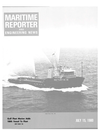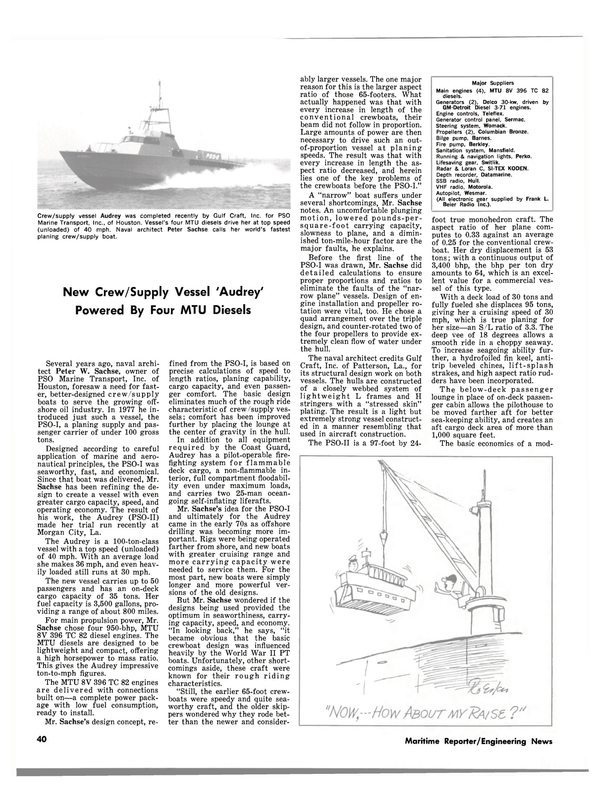
New Crew/Supply Vessel 'Audrey' Powered By Four MTU Diesels
Several years ago, naval architect Peter W. Sachse, owner of PSO Marine Transport, Inc. of Houston, foresaw a need for faster, better-designed crew/supply boats to serve the growing offshore oil industry. In 1977 he introduced just such a vessel, the PSO-I, a planing supply and passenger carrier of under 100 gross tons.
Designed according to careful application of marine and aeronautical principles, the PSO-I was seaworthy, fast, and economical.
Since that boat was delivered, Mr.
Sachse has been refining the design to create a vessel with even greater cargo capacity, speed, and operating economy. The result of his work, the Audrey (PSO-II) made her trial run recently at Morgan City, La.
The Audrey is a 100-ton-class vessel with a top speed (unloaded) of 40 mph. With an average load she makes 36 mph, and even heavily loaded still runs at 30 mph.
The new vessel carries up to 50 passengers and has an on-deck cargo capacity of 35 tons. Her fuel capacity is 3,500 gallons, providing a range of about 800 miles.
For main propulsion power, Mr.
Sachse chose four 950-bhp, MTU 8V 396 TC 82 diesel engines. The MTU diesels are designed to be lightweight and compact, offering a high horsepower to mass ratio.
This gives the Audrey impressive ton-to-mph figures.
The MTU 8V 396 TC 82 engines are delivered with connections built on—a complete power package with low fuel consumption, ready to install.
Mr. Sachse's design concept, refined from the PSO-I, is based on precise calculations of speed to length ratios, planing capability, cargo capacity, and even passenger comfort. The basic design eliminates much of the rough ride characteristic of crew/supply vessels ; comfort has been improved further by placing the lounge at the center of gravity in the hull.
In addition to all equipment required by the Coast Guard, Audrey has a pilot-operable firefighting system f o r flammable deck cargo, a non-flammable interior, full compartment floodability even under maximum loads, and carries two 25-man oceangoing self-inflating liferafts.
Mr. Sachse's idea for the PSO-I and ultimately for the Audrey came in the early 70s as offshore drilling was becoming more important.
Rigs were being operated farther from shore, and new boats with greater cruising range and more c a r r y i n g c a p a c i t y were needed to service them. For the most part, new boats were simply longer and more powerful versions of the old designs.
But Mr. Sachse wondered if the designs being used provided the optimum in seaworthiness, carrying capacity, speed, and economy.
"In looking back," he says, "it became obvious that the basic crewboat design was influenced heavily by the World War II PT boats. Unfortunately, other shortcomings aside, these craft were known for their rough riding characteristics.
"Still, the earlier 65-foot crewboats were speedy and quite seaworthy craft, and the older skippers wondered why they rode better than the newer and considerably considerably larger vessels. The one major reason for this is the larger aspect ratio of those 65-footers. What actually happened was that with every increase in length of the conventional crewboats, their beam did not follow in proportion.
Large amounts of power are then necessary to drive such an outof- proportion vessel at planing speeds. The result was that with every increase in length the aspect ratio decreased, and herein lies one of the key problems of the crewboats before the PSO-I." A "narrow" boat suffers under several shortcomings, Mr. Sachse notes. An uncomfortable plunging motion, lowered pounds-pers q u a r e - f o o t carrying capacity, slowness to plane, and a diminished ton-mile-hour factor are the major faults, he explains.
Before the first line of the PSO-I was drawn, Mr. Sachse did detailed calculations to ensure proper proportions and ratios to eliminate the faults of the "narrow plane" vessels. Design of engine installation and propeller rotation were vital, too. He chose a quad arrangement over the triple design, and counter-rotated two of the four propellers to provide extremely clean flow of water under the hull.
The naval architect credits Gulf Craft, Inc. of Patterson, La., for its structural design work on both vessels. The hulls are constructed of a closely webbed system of l i g h t w e i g h t L frames and H stringers with a "stressed skin" plating. The result is a light but extremely strong vessel constructed in a manner resembling that used in aircraft construction.
The PSO-II is a 97-foot by 24- foot true monohedron craft. The aspect ratio of her plane computes to 0.33 against an average of 0.25 for the conventional crewboat.
Her dry displacement is 53 tons; with a continuous output of 3,400 bhp, the bhp per ton dry amounts to 64, which is an excellent value for a commercial vessel of this type.
With a deck load of 30 tons and fully fueled she displaces 95 tons, giving her a cruising speed of 30 mph, which is true planing for her size—an S/L ratio of 3.3. The deep vee of 18 degrees allows a smooth ride in a choppy seaway.
To increase seagoing ability further, a hydrofoiled fin keel, antitrip beveled chines, l i f t - s p l a sh strakes, and high aspect ratio rudders have been incorporated.
The below-deck passenger lounge in place of on-deck passenger cabin allows the pilothouse to be moved farther aft for better sea-keeping ability, and creates an aft cargo deck area of more than 1,000 square feet.
The basic economics of a mod- ern crew/supply boat are determined by her ton-mile-hour factor when heavily loaded, in combination with high absolute speed for hotshot or personnel runs. Greater speed becomes ever more important as rigs are built farther o f f s h o r e , Mr. Sachse explains.
Vessels must be able to complete a trip in 12 hours, according to U.S. Coast Guard regulations, or carry a second skipper, adding greatly to operating expense.
The design cruising speed of the Audrey allows her to turn around within 12 hours, and thus her owner can run her up to seven trips a week. And that, adds her designer, is the single most important criterion for a fast, offshore supply and passengercarrying vessel.
Read New Crew/Supply Vessel 'Audrey' Powered By Four MTU Diesels in Pdf, Flash or Html5 edition of July 15, 1980 Maritime Reporter
Other stories from July 15, 1980 issue
Content
- Hitachi Receives First U.S. Order For Two Jackup Drilling Rigs page: 7
- Mangone Delivers Advanced Offshore Research Vessel page: 8
- Fireboat Gulf Fleet No. 40— 100th Vessel Joins A Growing Fleet page: 10
- O&K Will Build Hopper Dredge For Indonesia page: 10
- New Primary Battery Introduced By SAFT —Literature Available page: 12
- Two New Contracts For Drill Barge And Jackup Won By Promet Private page: 12
- W.L. Rose Jr. Named President Of Williams-McWilliams page: 15
- Samson Offers New Shear Pin Shackle- Literature Available page: 15
- Canada's Arctic Pilot Project page: 16
- Two Naval Architects Join Waller & Assoc. page: 18
- Bill Cleary Honored By AWO Board, Moynihan page: 18
- Brochure Available On Norshipco's Three Expanded Shipyards page: 22
- Cliff Drown Named New President Of State Boat page: 22
- Steam Engine Literature Available From Skinner page: 22
- Butterworth Introduces Marine Liqua-Blaster —Literature Available page: 24
- Firm Changes Name To Houston Marine Services page: 24
- Jurgen Manske Named Representative For Hapag-Lloyd Service page: 24
- Leggett, Lowen And Singman Named To NMC Board Of Governors page: 25
- French And Campbell Named To Head NMC Shipyard Council page: 27
- Lockheed Places $8.6-Million Order For Colt/Pielstick Diesel Engines page: 28
- McDermott Scotland Gets $92-Million Contract From Marathon Oil U.K. page: 30
- Maintenance Guide For Shipboard Officers Offered By Chesterton page: 30
- 100,000-dwt Floating Dry Dock Increases HUD's Tsing Yi Capacity page: 33
- Literature Available On Foxboro's New On-Line Ferrograph page: 33
- Innovative Tugboat #Jekyll Isle7 Delivered By Gladding-Hearn page: 34
- Dixie Ships First Of 5 New Dredges To The Egyptian Dredging Co. page: 34
- Fuel Conservation Subject Of N.Y. SNAME Symposium Sept. 22-23 page: 35
- New Crew/Supply Vessel 'Audrey' Powered By Four MTU Diesels page: 40
- Caicos Petroleum Services Establishes Transfer Facility page: 41
- Title XI Approval For Three Product Carriers To Cost $197 Million page: 42
- Title XI Sought For 20 Barges And 3 Towboats page: 42
- Ingram Exploration Names Thomas M. Ellis Jr. VP Of Exploration page: 43
- Atlantic Marine To Build Two NSF Research Ships At Cost Of $5.9 Million page: 43
- Pielstick Diesels To Power French Navy And Yugoslavian Vessels page: 44
- Swanson Promoted To VP & General Manager Of Dillingham Shipyard page: 45
- Orders For Six Ships To Cost $180 Million Placed By Cast Group page: 45
- Proposed Shipboard Maneuvering Data page: 46
- J.R. Mills Appointed At New Allis-Chalmers Marine Diesel Division page: 48
- Sartor And Jones Promoted To New Posts At Farrell Lines page: 49
- Electro-Nav Acquires Marine Division Of British Electronics Firm page: 49
- SNAME Chesapeake Section Hears Update Report On Design Of Multipurpose Mobilization Ship page: 50
- AFO Shipyards Appoints Representative For U.S. And Canada page: 51
- NASSCO Lays Keel For Second Union Oil Product Carrier page: 52
- Levingston To Build $37-Million Jackup Rig For Noble Drilling Corp. page: 54
- O&K Shipyard Delivers Offshore Crane Platform Designed By RSV Gusto page: 54
- Submersible Deck Cargo Barge Delivered To Nedbarges Sublift page: 58
- Mangone Launches Special Purpose Tanker For Sun Transport page: 58
- Offshore Construction For $50-Million Pipeline Goes To J. Ray McDermott page: 59


